|
Yehuda Stolov Interfaith Encounter Association: Harmony among Jews and Palestinians The Interfaith Encounter Association (IEA) was formed in the summer of 2001 and works since to promote genuine coexistence and sustainable peace, through joint community building on the grassroots level, using interactive interfaith dialogue as its vehicle. The a-political and all-inclusive approach of the organization and its activities continuously form the human infrastructure for peace in the Holy Land. In its ten years of existence, the IEA have held – in its three regional focuses: in Israel, between Israelis and Palestinians and in the larger Middle East – more than 1000 programs, with thousands of participants. A most significant fact is that the participants in IEA programs include people of all political and religious views, as well as all ages, genders, walks of life etc; and that the vast majority of them have met 'the other' for the first time through IEA. The IEA have formed till now 41 on-going community-groups of interfaith encounter – from the Upper Galilee to Eilat, including 10 groups that bring together on a regular basis Israelis and West Bank Palestinians. Among the latter we maintain the three only groups in the country that bring together Palestinians with Settlers. IEA maintains working relations with 7 Palestinian organizations, across the West Bank and the Gaza Strip and is a founding partner of the Middle East Abrahamic Forum, including Egypt, Iran, Jordan, Lebanon, Morocco, Tunisia and Turkey. In 2010, IEA sponsored 165 encounters and events of various interfaith groups. Sixty of these encounters involved children, youth, and university students. Cumulatively, over 4,000 people attended its groups in 2010, many taking part on a regular basis. The IEA sponsor groups meeting both within the "Green Line" and in the West Bank, providing safe spaces for respectful discussions of issues relating to participants' religious beliefs. It is through these meetings, discussions, and time spent together that warm and understanding relationships are built and maintained among people of different faiths, cultures, and communities. Beyond the groups' regular work, IEA had in the last year new areas of activity: ·For the first time since the beginning of the Second Intifada's violence, our Jerusalem-Hebron Youth Interfaith Encounter held a joint encounter and visit to the Palestinian-controlled part of Hebron. We were the first Israeli group to enter these parts of Hebron with permission from the army. The same group is organizing an encounter in Tel Aviv-Jaffa, enabling its Palestinian members to visit the sea for the first time in ten years (for some it will be their first time!) ·The "Circle of Light and Hope" Israeli-Palestinian Interfaith Encounter group organized a historic visit of Palestinian Muslims to the Friday night services of the (Orthodox) Kehilat Yedidya Synagogue in Jerusalem. ·The coordinators of the "A/Nahnu" Youth Interfaith Encounter in the Mt. Scopus campus of the Hebrew University obtained the agreement of the university's authorities to open a Muslim Prayer Room on campus. Furthermore, the intention is to make this room as the center for interfaith encounter activity. ·The coordinators of the group of Students from Hebrew University and Bethlehem University initiated a joint Israeli-Palestinian business venture for fair-trade marketing of olive oil, for funding activities of interfaith encounter. ·IEA began cooperating with the Feuerstein Institute in Jerusalem in bringing Palestinian children from Hebron and Gaza, who suffer from different forms of brain damage, for treatment and training at the Feuerstein Institute. ·With the additional support of the Anna Lindh Foundation, we initiated a major new project, the Euro-Mediterranean Abrahamic Forum. The first meeting took place in Amman with over 60 participants from seven Middle Eastern and five European countries, and was tremendously successful. The second one took place in Lublin, Poland in May 2011, and included a joint historical visit of such a mixed group to the nearby Majdanek Death Camp. For its work the IEA has been recognized by UNESCO as "an organization that promotes the culture of peace" and awarded the 2006 Prize for Humanity by the Immortal Chaplains Foundation. In 2007 Two of IEA's coordinators won the Women's Peace Initiative Award of the Tanenbaum Center for Interreligious Understanding and the IEA was the recipient of the 2007 INTR°A-Project Award for the Complementation of Religions of The Institute for Interreligious Studies. The film "Interfaith Encounter in the Galilee", produced by IEA to present the work of its school-twinning project, was awarded the Commendable Effort by the World Peace Film Award 2007 of the World Movement for Global Democracy. In May 2008, the IEA was one of the sixty projects, selected as "the entrepreneurial projects that will change the face of Tomorrow" to present at the Israeli Presidential Conference. The IEA experience is very important for the conscious building of peace from harmony in the world. The article contents as a whole is expressed in the tetranet thinking model-48, which represent the philosophy of social harmony acceptable for all: 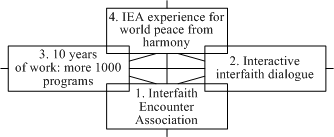 Yehuda Stolov is the executive director of the Interfaith Encounter Association, an organization that works to build peaceful inter-communal relations in the Holy Land by fostering mutual respect and trust through active interfaith dialogue. Dr. Stolov has lectured on the role of religious dialogue in peace-building throughout the world. He holds a B.Sc. and an M.Sc. in Physics and a Ph.D. from the Hebrew University of Jerusalem. Address: P.O. Box 3814, Jerusalem 91037, Israel Web: www.interfaith-encounter.org E-mail: yehuda_at_interfaith-encounter.org Nadeem Masih Muslims and Christians of Pakistan: Peace, Harmony and Reconciliation On June 26th, 2011 Human Welfare Organization (HWO) conducted one Day Capacity Building Training Program on Peace, Harmony and Reconciliation at Dee Paradise Hotel, Toba Tek Singh, Pakistan. 50 persons participated in this training program. HWO also invited political, social personalities and government officials of district Toba Tek Singh, such as Chaudhary Mohammad Ashfaq and Rev. Fr. Bonnie Mendes. Mr. Nadeem Masih, the HWO director, and they welcomed all the participants. Mr. Faryad Younas Coordinator of this one day training shared the objectives of the training: ·To know about peace, harmony and reconciliation, ·To train local leaders how to promote peace, harmony and reconciliation at grassroots level in their respective areas, ·To devise a plan to promote peace, harmony and reconciliation by defusing and deescalating tension in their respective areas of Gojra and Toba Tek Singh Miss Razia Shoukat Coordinator of Working Children Program Caritas Pakistan Faisalabad and Mr. Tasawar, Coordinator for Interfaith Harmony and Peacebuilding Program Star Organization, were the resource persons of the training. They shared the concepts of peace, harmony and reconciliation and the knowledge of how leaders can promote them in their areas. They said: Reconciliation is accepting others and renouncing to absolutize differences. Living with love is the state of peace, harmony and reconciliation. Reconciliation is to share the suffering of others, leaving all hatred and prejudice. They also said our religions teach us values for pleasant and peaceful life. No religion teaches its followers to fight in the name of religion. No one can win the hearts of others through war and fight but only with love, tolerance respect, sharing forgiving and acceptance. We must respect the religious values of others. The resource persons divided the participants into 5 groups and gave them questions concerning how we, the leaders, can promote peace, harmony and reconciliation in respective areas. The groups presented their reports as: Through giving religious freedom to others. Through unity, sharing, getting together, and getting organized without any differences of religions and sects. Providing justice to others in our daily life. Respecting rights of others and performing our duties. Use of electronic and print media. Living with love, reconciliation, equality and tolerance. Encouraging peaceful dialogues. Having Corner meetings and organizing Awareness seminar and presenting Interactive and street theatre and making Peace songs and movies. Fr. Bonnie Mendes, Catholic priest. (Presently working as Regional Coordinator for Caritas Asia, Thailand. He was awarded with a peace award from Association for Communal Harmony in Asia – ACHA – Oregon state USA.) Fr. Bonnie proposed that our focus should be peace, harmony and reconciliation. He urged the need of forming small groups, local peace committees and to make them functional to promote peace, harmony and reconciliation at grassroots level. These committees should have three years plan, Peace for Road, Peace for People and Peace for Streets and do the work accordingly by forming small groups and communities by carrying out small activities and taking initiatives of love, forgiveness, sharing, acceptance and tolerance. While talking on the subject, he gave the example of computer. He said that we must delete all the negative information, feelings and spirit from our memory and must save positive attitudes, feelings, values and emotions for others. Ch. Muhammad Ashfaq, Muslim political leader (Ex-Parliamentarian both at National and Provincial Assemblies. Head of the Local District Government) He said that he congratulates organizers for organizing this training program on very important issues. He said that we should follow the teachings of our religions. Every religion gives the message of love, tolerance, sharing, reconciliation, peace and harmony. If we follow what our Holy Prophets told us then there will be no intolerance hatred, violence, disharmony and tension in the country. In order to teach participants the way the leaders can promote peace, harmony and reconciliation, there was a performance made by a role play team. In the role play a conflict was resolved by the leaders, teacher, councilor and community leader (Chaudhary). The positive role of these characters was highlighted to promote peace, harmony and reconciliation. A plan of action was also devised for the next year. Short term Plan: Forming Local Peace Committees. Meetings with leaders of the communities. Arranging Iftaar parties. Women as Peace Maker campaign Long term Plan: Making peace songs, poster and essay competitions. Peace Education Program in Schools for behavior change. Installing peace poles at different places. Use of electronic and print media to promote peace harmony and reconciliation. Exchange programs within communities to learn by seeing and living together. Involving Local Government. Building Peace, Harmony and Reconciliation networks. Lobbying and advocacy with movement concerning departments. At the end of the training, Mr. Nadeem Masih, HWO director, thanked all the participants. He expressed the hope that leaders will take active part in promoting peace, harmony and reconciliation at grassroots level to end together hatred, injustice, intolerance from societies and promote, love, forgiveness and tolerance in our culture. The article key content is presented in the model-49 of tetranet harmonious thinking: 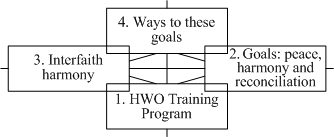 Nadeem Masih, Director, Human Welfare Organization. Address: Toba Tek Singh, Pakistan; E-mail: hwopk04_at_gmail.com María Cristina Azcona The ABC of Social Harmony In order to start the study of Social Harmony, we need to develop a complete glossary of concepts, words and topics regarding the main concept: Harmony. Personal harmony: Each individual must find out the way to harmonize the inner world by structuring effectively and harmonically the cognitive, affective and spiritual parts of the personality, being. Cognitive aspects: a) A profound level of thought based on high and simple moral values. b) Good habits, good behavioral patterns. c) A solid and at the same time flexible way of thinking, not based on prejudices or pre/conceptualizations. d) An open mind orientated towards wisdom, beginning with healthy curiosity, all the time, which leads to knowledge and understanding of the Truth. e) Capability to study new technologies in a non-stop manner. f) An operative acknowledgement of native language and other. g) Awareness of the necessity to be continuously informed about geography, biology, history and other sciences. h) Capability to have an independent logic thought, based on strong developed abilities. Affective aspects: a) Self esteem, b) Equilibrium between bad and good energies, c) Mental health, d) Good relationship with others. Spiritual aspects: a) Self control, b) A stable scale of values, c) Construction of virtues or good habits, d) To have an artistic hobby like literature or poetry or an altruistic activity like volunteering at hospitals. Social harmony: To live in harmony means nothing different from what Ada Aharoni calls "Vivre ensemble". In other words, to find a way of living all together without struggles, resolving conflicts peacefully. This concept applies to small groups, like family groups and small villages. But: what about the Global Village itself. Is it possible to find this kind of life for the entire world? Leo Semashko has developed a theory called tetrasociology aiming to find out the way of harmonious living for different nations and cultures. Global harmony: Developing this way of living is similar to reconstructing a crystal jar manufactured by a million hands through history. When its equilibrium gets unstable and breaks, its fragments spread around and stab into a million hearts, from where a new chain of cooperative work gets a start, and with the unique weapon of education, it reaches a new stability, again and again, enforcing its strength even more and more, each time it is being reestablished. Culture is the "Totality of socially transmitted behavior patterns, arts, beliefs, institutions, and all other products of human work and thought" as it said in "The American Heritage English Dictionary". In this sense, culture includes Peace as an acquisition of society. We can define Peace as a cultural value that consensually leads human society towards the protection of life. Peace allows life to grow, culture to be developed and systematic education and non-systematic education to be forwarded and transmitted. We valuate Peace when it is not updated, when it is absent from a historic period of time in society groups. The lack of peace brings humanity to fear, desperation, annoyance, distrust and isolation. Also it destroys any possibility of philosophic development regarding the cherishing of life. Lack of Peace does not only lead to violence, but also results in a violent environment and a paranoid climate. The effects are devastating for art, science and literature. The economic resources and political decisions and interests are concentrated in defensive or offensive activities and not in the maintenance of education or the aim to assist poor citizens groups. But there is a great problem: Is it possible to reach peace without developing a harmonious way of building international relations among nations? Global Harmony is the first and foremost important value to be pursued if humanity has any hope of subsistence. Without this reasoning humanity has no hope of subsistence. So let's enumerate the steps towards harmonizing the Global Village: A state of righteousness, an international Law of Education based in the education in inner harmony, a change of mind where the Golden Rule will be the first Law. A democratic state where power is in rotation of political groups and population opinions are represented by the official government. Education is the key to social changes because it is oriented on the new generations. But, it has failed its noble mission and the result is catastrophic. Education in the traditional sense will not be rapid enough to avoid awful consequences of millenniums of mistakes. We must work all together in order to pave the conscious way towards harmonious civilization. Personal, social and global harmony are united in harmonious civilization, the concept of which is detailed in the ABC and other GHA books [3; 4; 5; 6]. The article postulates as a whole are expressed in the model-50 of tetranet harmonious thinking, representing the philosophy of social harmony in our ABC: 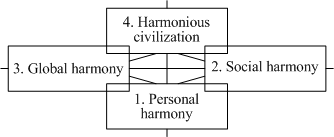 María Cristina Azcona works as an Educational Psychologist, Family Counselor and specialist in forensic psycho-diagnosis. She has obtained two university titles. Bilingual MCA poets for peace: founder, IFLAC South America and Argentina director among other honorary titles. GHA, co founder and Vice-president, UHE Vice president. The Love Foundation Argentina Director. Being a well-known bilingual poet, writer and editor with many published books in Argentina, UK, and India, she has articles on fiction and poems. She has been awarded literary prizes in international poetry contests in México, Argentina and India, also has been called Symbol of Peace and Muse of harmony. Is considered as Peace Leader by American Biographical Institute, and UNESCO. Human DHS-NY Education team. Academician member. Address: Buenos Aires, Argentina. E-mail: azconacristina_at_hotmail.com Web: www.azcona.bravehost.com, www.peacefromharmony.org/?cat=en_c&key=36 Habyarimana Héli African Forms of Social Harmony Each particular society develops and valorizes its own specific forms of social harmony. Africa has got moral principles, rules and values that actually guide and influence peoples' lives, and they are reflected in language, religion, social structure, culture, life and its everyday practices. They determine the concepts of good and bad, right and wrong, humanism, humanity, brotherhood, and the common good. African socialism refers to sharing resources in an African traditional way, which covers all facets of people's life. It is intertwined with African identity and unity. Moreover, it is closely linked with the African communalism, which confers to Africans the values of unity of being, family hood or consanguinity, openness, mutual commitment and co-operation, and interdependence [65]. The two above principles corroborate the African though that the community has priority over the individual. Mbiti's thesis [66] "I am because we are, and since we are, therefore I am", emphasizes the African communitarian ethos which runs counter to selfhood but rather highlights the umbilical linkage with and between generations. The concept of Ubuntu /ʊbʊntu/ has been one of eminent forms of social harmony in Africa. It stresses people's interconnectedness since no one can exist as a human being in isolation as the Zulu maxim states 'umuntu ngumuntu ngabantu (a person is a person through other persons)'[67]. Ujamaa /ʊdƷa'ma:/ is the East African value which entails the notion of family hood and stresses that one becomes a person through the people or community. Its sibling Harambee /haram'be:/ (all pull together) encourages communities to work together and to valorise more community efforts rather than individualistic interests[68]. It is not far from the concept of Fihavanana, which stresses that people are all one blood and thus they should be proactive about goodwill for the good of one another and the world. As for the Rwandan concept of ubupfura /ʊbʊ'pfʊra/, it encompasses all best practices promoting the human dignity, and it entails getting rid of all evils and all sorts of immorality. Any society that has ubupfura is harmonious, whereas people lacking it are inhuman. Finally, when people fail to live in harmony, the African society has been resorting to punishment, which is not for penalty purposes, but rather contributes to the common good and the reintroduction of social harmony. It establishes that the society is in a good and governable state, and it assumes the recipients' responsibility for their actions as well as their submission to the society [69]. With all the specificity of African culture, we find in it those same twenty fundamental elements/spheres of social harmony, which are inherent for the global world as a whole and which are detailed in the first part of the ABC of Harmony. As well as the rest of the world, African society also can not exist without the four necessary and sufficient resources: people, information, organizations and things (PIOT). It also can not exist without the four necessary and sufficient processes of reproduction of these resources: production, distribution, exchange and consumption (PDEC). Moreover, African society also can not exist without the four necessary and sufficient spheres of reproduction of these resources: sociosphere, infosphere, orgsphere and tehnoekosphere (SIOT). Finally, African society also can not survive without the four necessary and sufficient sphere classes of the population engaged in four areas: socioclass, infoclass, orgclass and technoclass (SIOT-classes). However, all of these resources, processes, spheres, and classes have the unique and unrepeatable form in the world. Difference and identity of the elements of harmony of African society determine not only the necessity for it, as for the world as a whole, of the general knowledge of these elements presented in the ABC, and an appropriate as well as harmonious education, but also and specifically, the African form, which must be determined by the African teachers and professors. Only in this case, African Society will become the organic part of global harmonious civilization, which is like all other parts in the fundamental elements of harmony, but unique in their form. This will be the civilization of harmonious unity of the diversity. It is the most sustainable and effective form of human and social existence. The content of the article is presented in the tetranet thinking model-51: 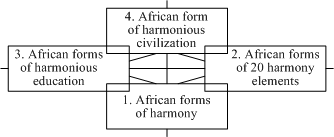
Habyarimana Héli: Linguist, Assistant Lecturer, Institute of Agriculture, Technology and Education of Kibungo (INATEK) – Rwanda, Kigali. Web: www.peacefromharmony.org/?cat=en_c&key=361 E-mail: haheli2001_at_yahoo.fr Genrih Skvortzov Harmonious Education The following essay was written during the development of the ABC of Harmony proposed by Global Harmony Association (GHA) as the foundation of Harmonious Civilization. Members of Global Harmony Association, by forming the main goal of the Association and preaching conscious harmony, contribute to the advancement of society towards harmonious ideal, promote education, humanization, reduction of conflictness, replacement of harmful consumer ideology with creative one. Methods of achievement of harmonization vary, however creative harmonious education (CHE) is considered to be the main one. A fairly universal model of creative harmonious education has not been created so far. The need in it is increasing but there is a significant resistance on the part of the present inharmonious world. The practiced education mainly produces tradesman, consumers (potential drug addicts, alcoholics and terrorists), and creators and decent persons exist in defiance of it. one of the failures of education was figuratively represented by Russian professor Michail Gromov, who is teaching students of a prestigious university in France [73]. This failure is caused by formalization that makes a student a fool, deprives them of creative aspirations. The second critical failure of education is the absence of systematic harmonious knowledge structure. It is not an exaggeration to say that in education the terror of facts or factology dominates. There is no holistic knowledge, within- and inter-subject harmonious connections that contribute to creative personality development. The widening gap between knowledge expounded and obtained by science in recent years is also similar to crisis. Nobody has suggested a way out of this crisis. Now let us pass to models of Harmonious knowledge construction which I have created during more than 40 years of pedagogical practice in schools and universities. The general scheme of harmonious education for any academic subject was realized in the program of unified natural science and published in the book "System of Laws of Nature" [74]. In this book the Law of natural harmonious proportion is determined. It consists of natural whole division into n parts. The known primitive of such kind is "golden section" (n = 2). The vast majority of natural objects are divided into three, four and more parts. If we take, for example, a middle finger and measure its components, we find out its ratio: 0.46, 0.32, 0.22. For a four-component natural object, for example, a hand, we find out division of this type: 0.38, 0.28, 0.2, 0.14. This coincides with the law of Leonardo da Vinci of human proportions. For a five-fold division there is: 0.33, 0.24, 0.19, 0.14, 0.10. The location of the planets of terrestrial group corresponds to the natural proportion. It turns out to be also valid for some mechanical, physical, chemical and social relations. This proportion is given in algebra section, while students themselves reveal it. The scheme of harmonious knowledge is given in algorithm onStLPMPb, including six elements: О – Оbjects, N – Notions, St – System theory, L – Laws, P – Principles, MPb – Мethods of Problems solution. Nowadays Creative Mathematics, Actual Physics, New knowledge theory and others has been constructed according to this model. [75]. Together with such knowledge organization productive psycho-imaginative-logical methodology of education and development is used, that determines the harmonious essence of Creative Technology of Education (СТО). Its first quality is a coherent pyramid of the studied subject. The law system of this subject is on top. It allows to attain the holistic vision of the subject and to orientate in its sections and connections between them. The system of principles instrumenting the laws is situated under them. These principles ensure application of laws to subject sections. Methods underlying the pyramid act as an instrument for solution of educational tasks and life problems. The productive educative methodology is based on the system of moral laws and activity for its realization. It is supported by the subject "Life School". The development of creative abilities is based on the innovations theory and imaginative color-sound perception of environment. It is supported by the subject "Person-Creator" with creative tasks in all art branches in accordance with student's interests. The imparted creative attitude in combination with assimilation of moral rules provides a firm basis for generation of decent harmonious personalities who will be alienated from negative addictions. A decent graduate can be rightly considered a harmonious person – homo harmonicus. A harmonious person with qualities of systematic knowledge, with the center in knowledge of elements and harmony laws, presented in its ABC, with positive motivation and orientation, with high creative and moral potential, is capable of eliminating arising conflicts in human psychology, in social and economic life. This determines the sense of conscious universal harmonization outgoing from a person. The logic of this article is expressed by the model-52 of tetranet thinking: 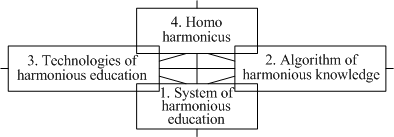 Genrih Skvortzov – member of Academy of Fundamental Education, author of Creative Technology of Education, books on knowledge technology, Ph.D. in Physics and Math Sciences, Systems Analyst. Address: Saint-Petersburg, Russia Web: www.superznanie.ru E-mail: gskvortsov_at_yandex.ru Steve Rajan Echoes of Inner Divine Harmony Our whole life depends on and evolves around our individuality. When our thoughts are focused on ourselves and the environment, we always have the feeling that "we exist". When we hold this book, we have the feelings that this book exists. Now let us ask ourselves "what is that existence" and how do we exist? Everything we experience in life through the five or sixth senses, packaged by its name and form, produces in us a feeling of existence. The human body and the entire creation is only a primordial existence of energy packets or quantas vibrating with individual names and forms, shaped by atoms and molecules and forces of nature. In reality, we are all bubbles and waves of vibration within a limitation of time and space. Birth, death, concept of peace from harmony are nothing but bubbles of waves of vibrations that exist on different planes of existence in the descending order of: The Soul Plane, Mental Plane, Astral Plane and finally the Physical Plane. Everything ages and changes in all the planes of existence. The concept of "peace from/through harmony" first existed in the soul plane as vibrating energy. The vibration became denser as electrons and protons became atoms through forces of attraction and later evolved into molecules and then into elements of nature – Earth, Water, Fire, Wind and Space. The human body is a different conduit to experience the elements of nature. The brain receives the sensations of elements of nature through the windows of the sense organs. The mind in the state of confusion could not discriminate and receives all sensations to be stored in the conscious, sub-conscious and unconscious part of the "mind" as sensations or engrams. When a child is born and first experiences light through its optic nerves, it does not see anything nevertheless the child's mind becomes one with the light. When the auditory nerve first experiences sound, the child's mind becomes one with the sensation of sound. Minute-in minute-out, the child begins to build its own repertories of sensations, engrams, experiences of its "existence" as memories. The memories that agree with our existence, we call them pleasant and memories that disagree, we call them painful and nightmare. The stored memories can affect all our metabolic changes, infinitesimally at the energy packets level resulting in the manifestation of conditions of ease or dis-ease in the physical frame of human physiology. The human birth is said to be the ultimate master piece of creation. Why then is the chaos, diseases, destructions and confusion? What is the purpose of the human birth? Why are we born? Where is our destiny? Where are we moving to from here? How can we enjoy the streams of joy and bliss vibration outside the inside of our consciousness? Our existence is determined by the number of breaths. Our destiny is determined by the number of breaths. We do not take a breath but RECEIVE a breath that takes us into the climax of life. The external stress of living has pigeon-holed us into a bubble of tragic living. How do we wake up from this dreamless state of sleep? At what point of living do we experience our individuality in life? At what point in life do we experience the bliss of human life – that unbroken existence. Are we awake, or living in a dream state or existing in a dreamless sleep state? The work we have joined hand to do on the platform of "Peace From Harmony" on the outside, can it remain unaffected and untangled by the internal turmoil of our existence? As we receive another breath now, we continue to exist in a vibratory state. How do we exist in relation to us? Can we transcend the three states of existence – Waking, Dream and Dreamless Sleep –to realize the true essence of our existence? Perhaps this exercise 30 minutes daily and it might help to experience the bliss within together with deep inner "Peace FROM Divine Harmony". In prayers, we speak to the Divine, in meditation, the Divine speak to us. The Inner Reality of Peace Through Harmony Contemplation Exercise: a.Sit in a comfortable position, close your eyes and focus on your breath for 3 minutes. b.Now say silently "God purifies my life, mentally, physically, emotionally and spiritually". c.Then wait for the echo coming from the Divine Source. Be a silent observer of the images of light and sound inside your head. Don't anticipate. Just Observe. d.Then say silently "God purifies my life, mentally, physically, emotionally and spiritually". Focus on the echoes. e.Then wait for the echoes coming from the Divine Source. Be a silent observer of the images of light and sound inside your head. Experience the flashes of happiness and state of peace from Divine harmony. This experience is very important for the conscious building peace from harmony in the world, for harmonious civilization and for harmonious education. The article contents as a whole is expressed in the tetranet thinking model-53, which represent the ABC philosophy of social harmony acceptable for all nations: 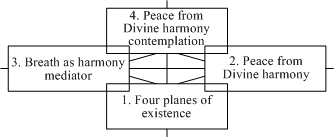 Steve Varatha Rajan – Founder and Chairman of Borneo Open International University, USA (www.borneo-edu.us); IAEWP Vice President for Strategy as well as GHA's Representative for Asia Pacific. In 2008, he had successfully organized the 18th IAEWP World Peace Congress in Malaysia. GHA Vice-President. Malaysia. Web: www.malaysian-iaewp.org, www.welcome2peace.org E-mail: steve_rajan_at_yahoo.com
Up
|